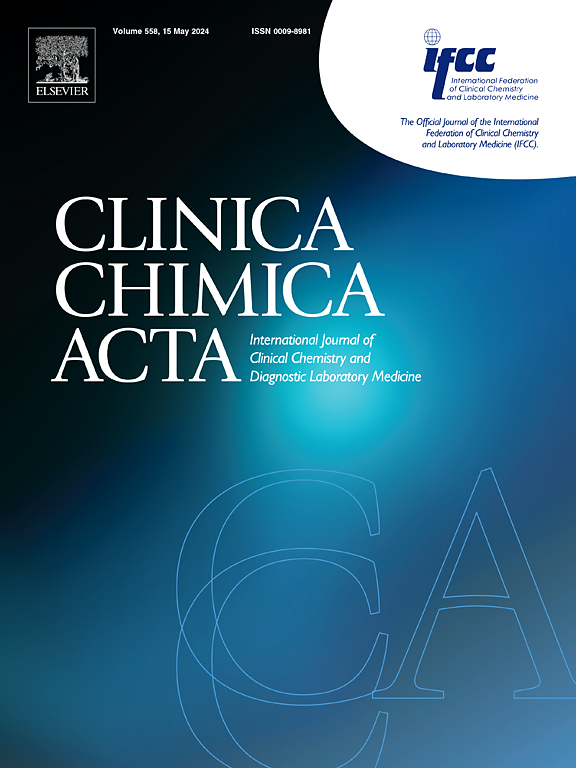99名中国ASS1携带者:遗传、代谢和瓜氨酸水平。
IF 2.9
3区 医学
Q2 MEDICAL LABORATORY TECHNOLOGY
引用次数: 0
摘要
瓜氨酸血症I型是一种常染色体隐性遗传病,由ASS1基因突变引起,而ASS1突变携带者通常只有一个等位基因突变。虽然携带者通常无症状,但他们经常表现出血浆瓜氨酸水平轻度升高。本研究旨在探讨ASS1携带者的遗传背景与血浆瓜氨酸水平的关系,以及其升高的可能机制。该研究分析了通过新生儿筛查确定的99名ASS1突变携带者。收集临床和遗传数据,包括初始和随访筛查时的血浆瓜氨酸水平。这是首次大规模分析ASS1突变与携带者血浆瓜氨酸水平之间的关系。鉴定出28个不同的变体,其中c.1087C > T (p.R363W)是最常见的。携带者血浆瓜氨酸水平升高,在前六个月呈先上升后下降的模式,在重新筛选期间达到65.84 µmol/L的峰值。此后水平逐渐下降,稳定在49.92 μmol/L左右,但始终高于正常参考范围。瓜氨酸阈值为62.04 µmol/L,可有效区分ASS1携带者和瓜氨酸血症I型患者(AUC = 0.984)。血浆瓜氨酸水平升高通常见于影响单体-单体界面的突变,尽管可能涉及其他机制。本研究确定了62.04 µmol/L作为新生儿筛查时区分ASS1携带者和瓜氨酸血症I型患者的参考阈值,观察了携带者前6个月瓜氨酸水平的动态模式,并提出了潜在机制中显性负作用的潜在作用。本文章由计算机程序翻译,如有差异,请以英文原文为准。
99 Chinese ASS1 carriers: Genetics, metabolism, and citrulline levels
Citrullinemia type I is an autosomal recessive disorder caused by mutations in the ASS1 gene, whereas ASS1 mutation carriers typically have a mutation in only one allele. While carriers are usually asymptomatic, they often show mildly elevated plasma citrulline levels. This study aims to investigate the relationship between the genetic background of ASS1 carriers and plasma citrulline levels, as well as the potential mechanisms behind the elevation. The study analyzed 99 ASS1 mutation carriers identified through neonatal screening. Clinical and genetic data were collected, including plasma citrulline levels at initial and follow-up screenings. This is the first large-scale analysis of the relationship between ASS1 mutations and plasma citrulline levels in carriers. Twenty-eight distinct variants were identified, with c.1087C > T (p.R363W) being the most common. Plasma citrulline levels in carriers were elevated, showing a rising then falling pattern over first six months, with a peak of 65.84 µmol/L during re-screening. Levels gradually declined thereafter and stabilized around 49.92 μmol/L, but consistently remained above the normal reference range. A citrulline threshold of 62.04 µmol/L effectively differentiated ASS1 carriers from Citrullinemia type I patients (AUC = 0.984). Elevated plasma citrulline levels are often seen in mutations affecting the monomer–monomer interface, though other mechanisms may be involved. This study identified 62.04 µmol/L as a reference threshold at the time of newborn screening to distinguish ASS1 carriers from Citrullinemia type I patients, observed a dynamic pattern of citrulline levels over the first six months in carriers, and suggested a potential role for dominant-negative effects in the underlying mechanism.
求助全文
通过发布文献求助,成功后即可免费获取论文全文。
去求助
来源期刊

Clinica Chimica Acta
医学-医学实验技术
CiteScore
10.10
自引率
2.00%
发文量
1268
审稿时长
23 days
期刊介绍:
The Official Journal of the International Federation of Clinical Chemistry and Laboratory Medicine (IFCC)
Clinica Chimica Acta is a high-quality journal which publishes original Research Communications in the field of clinical chemistry and laboratory medicine, defined as the diagnostic application of chemistry, biochemistry, immunochemistry, biochemical aspects of hematology, toxicology, and molecular biology to the study of human disease in body fluids and cells.
The objective of the journal is to publish novel information leading to a better understanding of biological mechanisms of human diseases, their prevention, diagnosis, and patient management. Reports of an applied clinical character are also welcome. Papers concerned with normal metabolic processes or with constituents of normal cells or body fluids, such as reports of experimental or clinical studies in animals, are only considered when they are clearly and directly relevant to human disease. Evaluation of commercial products have a low priority for publication, unless they are novel or represent a technological breakthrough. Studies dealing with effects of drugs and natural products and studies dealing with the redox status in various diseases are not within the journal''s scope. Development and evaluation of novel analytical methodologies where applicable to diagnostic clinical chemistry and laboratory medicine, including point-of-care testing, and topics on laboratory management and informatics will also be considered. Studies focused on emerging diagnostic technologies and (big) data analysis procedures including digitalization, mobile Health, and artificial Intelligence applied to Laboratory Medicine are also of interest.
 求助内容:
求助内容: 应助结果提醒方式:
应助结果提醒方式:


